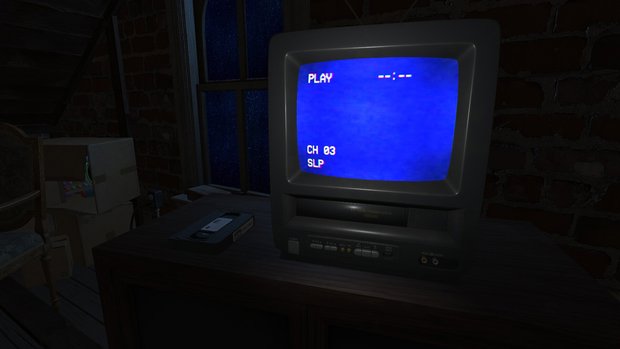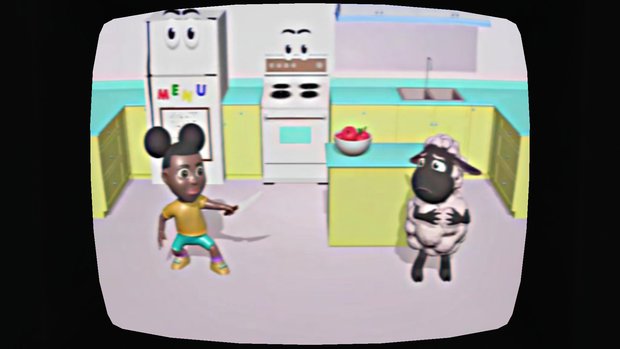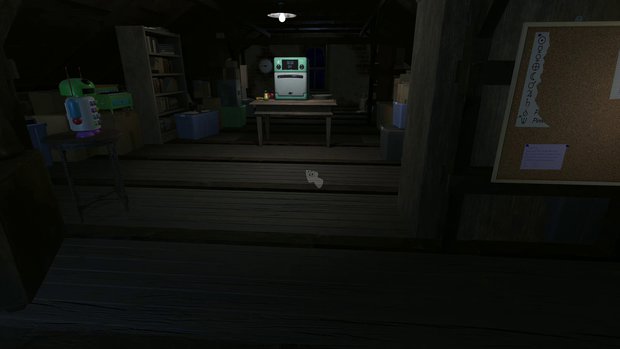Amanda the Adventurer review – Cleverly conceived but weakly programmed analog horror is largely a turn-off

- 3 Comments
Imagine that you have inherited your late aunt’s home. When you explore the attic, you discover that your aunt was investigating a series of disappearances connected to a popular local access television show. Through a letter apparently written shortly before her death, your aunt tells you that if you want to know more, you must watch the video tape resting next to the television glowing in the darkness. But she leaves you with a warning: once you play the tape, there is no turning back. Reluctantly, you put the tape in the VCR, and you are greeted by the disarming animated duo of Amanda and her pal, Wooly the Sheep. But something doesn’t seem quite right about the way Amanda’s looking at you…
It’s a compelling premise, and this is the atmosphere that MANGLEDmaw Games seeks to create with their first-person analog horror game, Amanda the Adventurer. I was really looking forward to it, as I am a fan of this recent web-driven subgenre of found footage horror built on Gen X and millennial childhood memories of grainy VHS tapes, the unsettling nature of emergency broadcasts, and the uncanny seriousness of ’80s and ’90s-era TV breaking news alerts. Oftentimes, rather than relying on cheap scares, analog horror builds a creepy mood of tension and unease, while also presenting an intriguingly cryptic story that invites viewers to come to their own conclusions.
Amanda the Adventurer, at least initially, manages to do precisely this. The Dora the Explorer-esque TV series it’s named after is ostensibly meant to teach children such basic knowledge as how to cook, tell time, parts of the body, and how to navigate their local stores. But as you progress through the first tape (there are others), two things become clear: not only is the relationship between Amanda and Wooly not as happy-go-lucky as it first appears, they are both aware of you as the viewer/player, and are attempting to communicate with you – Amanda, to manipulate you; Wooly, to warn you. Each new tape becomes progressively more degraded in quality and unsettling in tone.
Unfortunately, while the horror game potential is almost deliciously palpable here, in practice Amanda the Adventurer turns out to be a very mixed bag of interesting ideas marred by a variety of issues. Aside from solid production values and a range of head-scratching, often obtuse brain-benders that will keep puzzle fans occupied for a while, an overreliance on cryptic story beats that raise more questions than answers, a barely-there plot, and an absence of truly scary experiences leave much to be desired at the end of this title’s 6-8 hour playtime.

The gameplay itself is fairly straightforward, requiring the mouse and keyboard to freely navigate the attic and interact with the myriad items stored there such as a toy oven, colorful robot, and of course the TV set and tapes of Amanda the Adventurer episodes. In addition, there is a bulletin board presumably used by Kate, your deceased aunt, to leave a smattering of clues and narrative threads for you to find. It’s all rather reminiscent of an escape room-style game, without the escape attempt. Alas, there isn’t much environmental variety to be explored here—the tapes themselves (and one ending) feature a few more locales, such as a doctor’s office, a candy shop, and a park, though you cannot control either the titular Amanda or Wooly.
When you’re ready, playing the first tape begins the game in earnest, with Amanda and Wooly preparing to bake a pie. In similar fashion to the way children’s shows attempt to get their young audience involved by “asking” them questions, Amanda asks the viewer what their favorite pie is. Unlike a kids’ show, however, you are actually able to respond to Amanda by typing in an answer via the keyboard. Through this mechanic, you are able to influence, to varying degrees, the outcome of the tapes you encounter. But beware, as it soon becomes apparent that Amanda is a malevolent, possibly demonic being who is sometimes angered by your responses.
The goals of the game are not especially well-defined at the outset, and it is possible to go through the first playthrough in only a few minutes, usually with lethal results. Amanda the Adventurer rewards multiple replays in this regard, with five endings that can be uncovered through exploration and experimentation. Upon dying or encountering one of the endings, you are sent back to the main menu, but with certain elements of your progress saved automatically. Clicking “continue” here will allow you to start over, but certain discovered items and conditions in the attic are carried over to the new playthrough. For instance, at one point you will need an item to activate the robot, but once you use this item, the robot will remain activated, even in subsequent playthroughs. Some of the tapes you discover will also be available without needing to go to the trouble of finding them again.
Careful observation is necessary in order to find clues scattered throughout the tapes that direct you to interact with items in the attic in a certain way, either to retrieve a needed item, or change the conditions on the tape currently playing in order to alter the outcome of the playthrough. For instance, one particular clue hidden on a tape indicates that you must put the dials on the toy oven on certain settings, at which point something dramatic happens in the kitchen on the TV show, leading to yet a different set of events occurring in the attic, inching the game toward a certain ending.

Although initially the tapes must be played from beginning to end, you will eventually gain the ability to pause them, allowing you to explore the attic while in the middle of watching them. This is not just a matter of convenience, as you will need to do so at certain times in order to interact with items in the attic while related things are displayed onscreen. Pausing also gives you the ability to examine clues that are displayed momentarily, which can be helpful when taking notes, if needed, but with no rewind or fast-forward functions, you’ll need to begin playing a tape from the start if you pass by something you want to return to.
I found this mechanic clever, but my powers of observation, or lack thereof, made it more frustrating than anything else. Scouring the visuals for anything out of place or even relevant to an item in the attic was an exercise in frustration for me, and led me all too often to walkthroughs on the internet to give me the needed push forward, robbing these puzzles of their satisfaction. Other tasks, such as a puzzle involving a piano, and an interesting challenge in which you look for certain (obvious) symbols on the tapes in order to activate a real-world device, are more straightforward, and if not exactly satisfying, do not require such intense observation to uncover their solution.
The repeated need to go back and replay the game over and over again doesn’t really help the rather lackluster horror element, either. While the atmosphere is initially tense, and there is some payoff in that Amanda’s uncanny facial expressions and outright sadistic behavior, coupled with a few disgusting and gory visuals, are rather startling at first (pretend animal harm warning: there is a very low-quality illustration of a bloodied, dead fox caught in a bear trap at one point, for instance, which Amanda finds great amusement in), continually replaying the game steals the surprise from the jump scares and the unsettling nature of the atmosphere.
The graphics are well done if fairly ordinary, with the in-game show being a computer-generated affair that wouldn’t look out of place on public television in the 1990s or early 2000s. The attic itself is more photorealistic, and manages to capture the grimy, aged aesthetic in a way that contrasts well with the whimsical animation of the show.

There are a few pieces of music in the game, most notably the titular TV show’s theme song. Again, these are nicely composed and appropriate, but nothing particularly noteworthy. Sound effects, such as button presses and drips of water, are likewise serviceable, and lend realism to your interactions with the environment. Perhaps more notable is the voice acting, which is quite impressive for an indie game. Likewise, the few live-action sequences found in a few videos would not be out of place in a more expensive production.
Narratively, however, Amanda the Adventurer stumbles rather badly. Although the atmosphere is suitably creepy, the game is so focused on providing endings for you to uncover that there really isn’t a “plot” to speak of – at least, not going by the tapes that you can readily find in pursuit of endings. Rather, there are morsels of backstory revealed throughout: the show’s creator disappeared, and so did his daughter. Other children disappeared, as well, after seeming to be (literally) entranced by the show. There is an insinuation that “telekinesis” is involved somehow.
If these tidbits don’t seem particularly enlightening, that’s because they aren’t, and not for fear of revealing spoilers. And unfortunately, even if you are able to uncover all of the secrets in the game, none of it ever amounts to a proper story, leaving you to fill in the fairly chasmic gaps with your own imagination. There are secret tapes you can find, but these require performing actions that are not at all obvious (all but one of them I learned about only from an online article about the game), and go against the grain of whatever you are actually supposed to be doing.
If you’re able to find these five secret tapes, their production values are decent, being live-action clips of various sorts that in one way or another provide a bit more background: interviews with in-game characters such as the show’s creator and a news clip regarding the controversy surrounding the program and the disappearance of the creator’s daughter, among others. The problem is that they raise more questions than answers, left entirely to the player to interpret and theorize about. Even the endings border at times on comical absurdity, leaving you to wonder what the hell it all means.
And this is perhaps my biggest gripe with Amanda the Adventurer. Even though analog horror is known for its cryptic storylines and fan theories, this game seems tailor-made not to enjoy as a self-contained, satisfying gaming experience, but rather as fodder for social media. In this respect, it harks back to the vociferous fan speculation of cult TV series like LOST and Game of Thrones, but without the writing and production quality to back up fan theories with plentiful clues. There is such a thing as being too cryptic, and the game unfortunately sprints headlong into this pitfall.
Instead of building out a compelling, coherent world that leaves just enough room for players to come up with their own answers, Amanda the Adventurer foregoes any sort of coherent story in favor of all-too-vague hints and borderline lazy reliance on common “spooky” tropes such as brainwashing. Which can often be forgiven, as long as there is a sense that it is leading up to something meaningful overall, and that the creators had a vision for an interesting tale to tell. Sadly, in this case it seems that vision got lost somewhere along the way, turning what could have been an incredibly interesting game in a burgeoning horror genre that is starting to break out into the mainstream, into a confusing, not very frightening, disappointment.
Final Verdict
There is some value here for those with the patience to play the game over and over again, and puzzle fans may enjoy some of the gameplay on offer. Ultimately, however, Amanda the Adventurer squanders most of its evident potential as an example of the analog horror genre by being too obtuse for its own good. Even with some excellent voice acting and high production values for an indie game, its underwhelming horror elements, an incoherent mishmash of backstory bits that raise questions but provide no answers, and the need to replay repeatedly to see everything crushes the initially effective spooky atmosphere and any real motivation to actually do so.
Hot take
Unless you are either a die-hard fan of puzzles or analog horror, and really don’t mind a lackluster and increasingly tiresome version of both, there are far better and spookier games out there than Amanda the Adventurer.
Pros
- Interacting with a haunted TV show is a clever premise for an adventure game
- High-production values with good voice acting and live-action elements
- Analog horror elements do make the game unsettling, at least at first
Cons
- Obscure puzzle clues can be frustrating
- Story is incoherent, bordering on lazy
- Replaying over and over again robs the game of truly being scary
- Overfocused on being cryptic, even by analog horror standards
Kacey played Amanda the Adventurer on PC using a review code provided by the game's publisher.

- Advertisement
- Help support AGH by advertising with us










3 Comments
Want to join the discussion? Leave a comment as guest, sign in or register.
This review is lazy.
Reply
Our writer reviewed the game using over 2,000 words (hardly lazy). You reviewed his review using four. We appreciate any constructive criticism and would love to hear a different perspective about the game.
Reply
It's obviously not, by any definition of the word. Want to try again, this time with something constructive?
Reply
Leave a comment